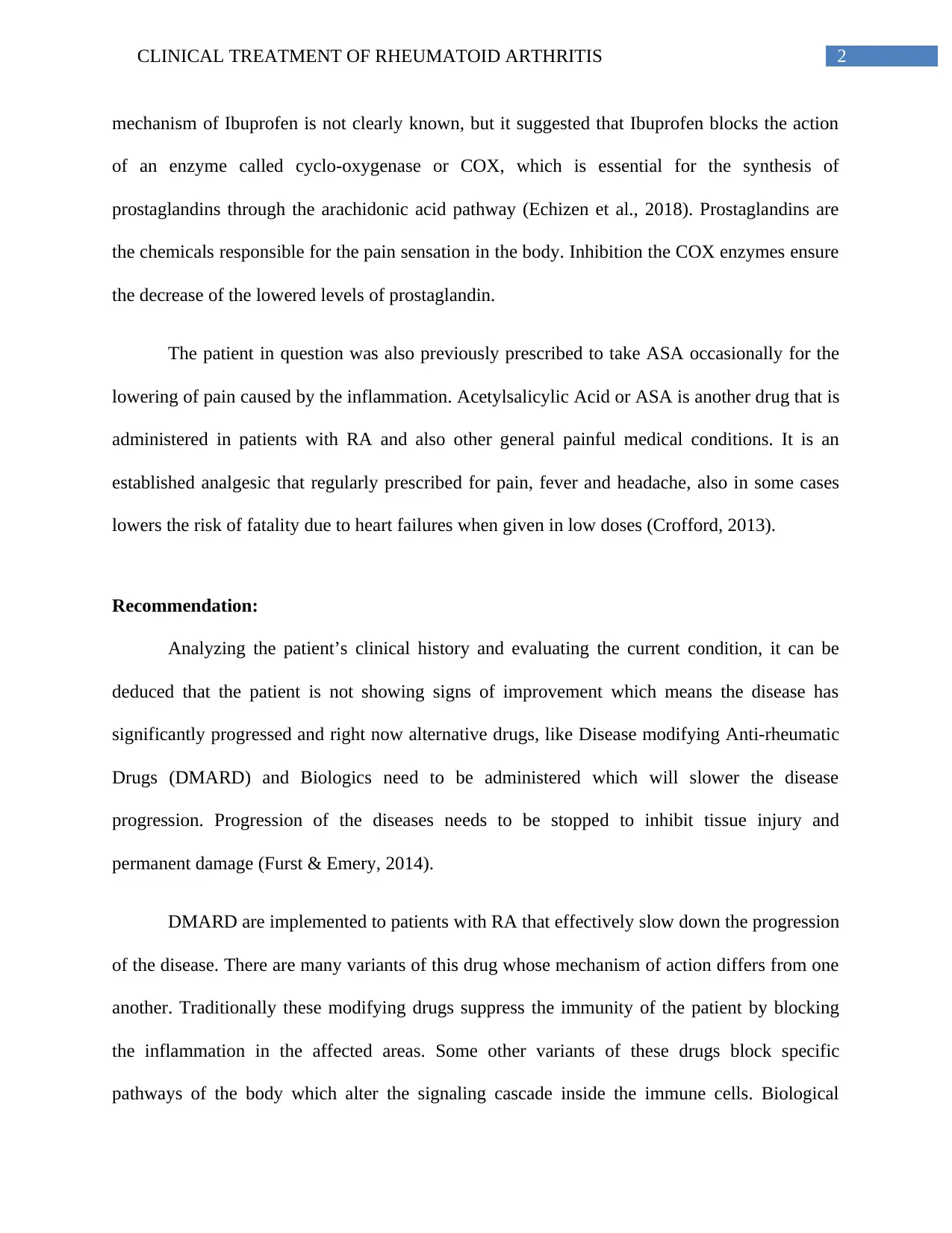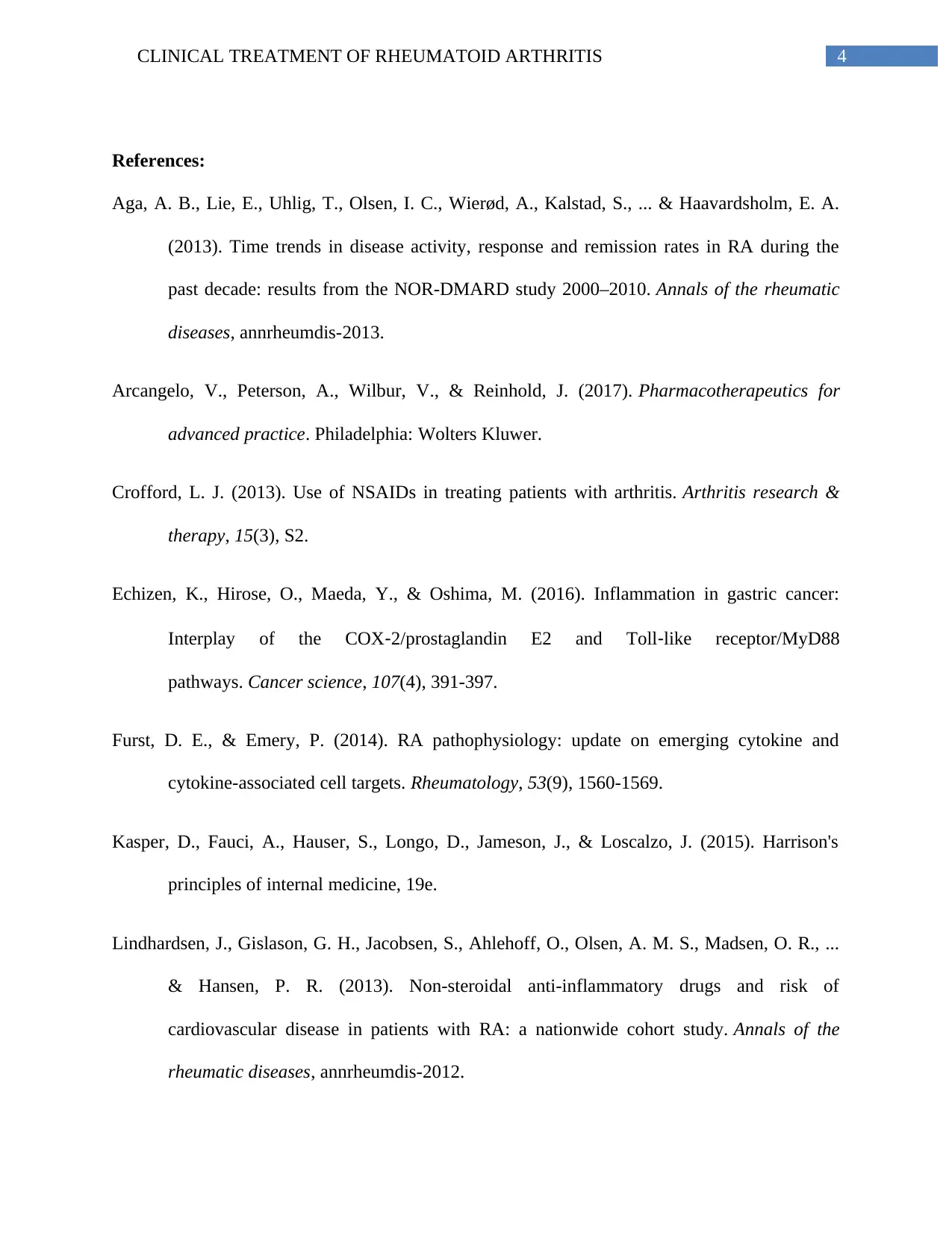Rheumatoid Arthritis Treatment: A Clinical Case Study Analysis
VerifiedAdded on 2023/06/15
|6
|1223
|109
Case Study
AI Summary
This case study examines the clinical treatment of Rheumatoid Arthritis (RA), focusing on a patient who experiences persistent pain despite regular analgesic use. The analysis highlights the limitations of NSAIDs like Motrin (Ibuprofen) and ASA in advanced RA cases. It recommends transitioning to Disease-Modifying Anti-Rheumatic Drugs (DMARDs) and biologics to slow disease progression and prevent tissue damage. Mild DMARDs such as Hydroxychloroquine and sulfasalazine are suggested as initial treatments due to their lower side effect profiles. The case study concludes that timely intervention with appropriate drugs is crucial to avoid permanent joint injury and deformity, emphasizing the importance of personalized treatment plans based on the patient's condition and medical history. Desklib offers a platform to explore similar solved assignments and study resources.

Running head: CLINICAL TREATMENT OF Rheumatoid Arthritis
Clinical Treatment of Rheumatoid Arthritis
Name of Student
Name of University
Author Note
Clinical Treatment of Rheumatoid Arthritis
Name of Student
Name of University
Author Note
Paraphrase This Document
Need a fresh take? Get an instant paraphrase of this document with our AI Paraphraser

1CLINICAL TREATMENT OF RHEUMATOID ARTHRITIS
Introduction:
Rheumatoid Arthritis (RA) is a form of autoimmune disease where the patient’s
immunological cells fail to distinguish between self-cells and antigens and attack body tissues.
This condition causes inflammation in the joints of the body leading to stress and pain followed
by swelling. The case study provided shows a similar situation where the patient fails to feel any
better even after prescription of analgesics. The disease may also spread to other parts of the
body in severe conditions (Furst & Emery, 2014). The patient that needs to be analyzed is
informed to have a history of RA and is currently undergoing pain even after regular dose of
Motrin 400 mg and occasional dose of Acetylsalicylic Acid or ASA.
Discussion:
The patient is shows the clinical symptoms of RA, that involve swelling of joints due to
inflammation causing pain. Severe progression of the disease may lead to stiffness and lack of
movement in the area. In some cases, the disease becomes a chronic inflammatory condition,
which can permanently destroy joint tissues and cause joint deformity (Arcangelo, Peterson,
Wilbur & Reinhold, 2017). The usual clinical trials include commencement of Non-steroidal
Anti-inflammatory drugs or NSAIDs (Lindhardsen et al., 2013) as well as disease-modifying
anti- rheumatic drugs or DMARDs.
Analysis of the medical history of the patient in the question reveals that he or she is
prescribed, Motrin 400 mg which is a common drug administered to patients suffering from RA.
This particular medicine is a brand name of Ibuprofen type of drugs (Kasper 2015). It is known
variant of NSAID to stop pain dental, menstrual, headaches as well as arthritic pain. The working
Introduction:
Rheumatoid Arthritis (RA) is a form of autoimmune disease where the patient’s
immunological cells fail to distinguish between self-cells and antigens and attack body tissues.
This condition causes inflammation in the joints of the body leading to stress and pain followed
by swelling. The case study provided shows a similar situation where the patient fails to feel any
better even after prescription of analgesics. The disease may also spread to other parts of the
body in severe conditions (Furst & Emery, 2014). The patient that needs to be analyzed is
informed to have a history of RA and is currently undergoing pain even after regular dose of
Motrin 400 mg and occasional dose of Acetylsalicylic Acid or ASA.
Discussion:
The patient is shows the clinical symptoms of RA, that involve swelling of joints due to
inflammation causing pain. Severe progression of the disease may lead to stiffness and lack of
movement in the area. In some cases, the disease becomes a chronic inflammatory condition,
which can permanently destroy joint tissues and cause joint deformity (Arcangelo, Peterson,
Wilbur & Reinhold, 2017). The usual clinical trials include commencement of Non-steroidal
Anti-inflammatory drugs or NSAIDs (Lindhardsen et al., 2013) as well as disease-modifying
anti- rheumatic drugs or DMARDs.
Analysis of the medical history of the patient in the question reveals that he or she is
prescribed, Motrin 400 mg which is a common drug administered to patients suffering from RA.
This particular medicine is a brand name of Ibuprofen type of drugs (Kasper 2015). It is known
variant of NSAID to stop pain dental, menstrual, headaches as well as arthritic pain. The working

2CLINICAL TREATMENT OF RHEUMATOID ARTHRITIS
mechanism of Ibuprofen is not clearly known, but it suggested that Ibuprofen blocks the action
of an enzyme called cyclo-oxygenase or COX, which is essential for the synthesis of
prostaglandins through the arachidonic acid pathway (Echizen et al., 2018). Prostaglandins are
the chemicals responsible for the pain sensation in the body. Inhibition the COX enzymes ensure
the decrease of the lowered levels of prostaglandin.
The patient in question was also previously prescribed to take ASA occasionally for the
lowering of pain caused by the inflammation. Acetylsalicylic Acid or ASA is another drug that is
administered in patients with RA and also other general painful medical conditions. It is an
established analgesic that regularly prescribed for pain, fever and headache, also in some cases
lowers the risk of fatality due to heart failures when given in low doses (Crofford, 2013).
Recommendation:
Analyzing the patient’s clinical history and evaluating the current condition, it can be
deduced that the patient is not showing signs of improvement which means the disease has
significantly progressed and right now alternative drugs, like Disease modifying Anti-rheumatic
Drugs (DMARD) and Biologics need to be administered which will slower the disease
progression. Progression of the diseases needs to be stopped to inhibit tissue injury and
permanent damage (Furst & Emery, 2014).
DMARD are implemented to patients with RA that effectively slow down the progression
of the disease. There are many variants of this drug whose mechanism of action differs from one
another. Traditionally these modifying drugs suppress the immunity of the patient by blocking
the inflammation in the affected areas. Some other variants of these drugs block specific
pathways of the body which alter the signaling cascade inside the immune cells. Biological
mechanism of Ibuprofen is not clearly known, but it suggested that Ibuprofen blocks the action
of an enzyme called cyclo-oxygenase or COX, which is essential for the synthesis of
prostaglandins through the arachidonic acid pathway (Echizen et al., 2018). Prostaglandins are
the chemicals responsible for the pain sensation in the body. Inhibition the COX enzymes ensure
the decrease of the lowered levels of prostaglandin.
The patient in question was also previously prescribed to take ASA occasionally for the
lowering of pain caused by the inflammation. Acetylsalicylic Acid or ASA is another drug that is
administered in patients with RA and also other general painful medical conditions. It is an
established analgesic that regularly prescribed for pain, fever and headache, also in some cases
lowers the risk of fatality due to heart failures when given in low doses (Crofford, 2013).
Recommendation:
Analyzing the patient’s clinical history and evaluating the current condition, it can be
deduced that the patient is not showing signs of improvement which means the disease has
significantly progressed and right now alternative drugs, like Disease modifying Anti-rheumatic
Drugs (DMARD) and Biologics need to be administered which will slower the disease
progression. Progression of the diseases needs to be stopped to inhibit tissue injury and
permanent damage (Furst & Emery, 2014).
DMARD are implemented to patients with RA that effectively slow down the progression
of the disease. There are many variants of this drug whose mechanism of action differs from one
another. Traditionally these modifying drugs suppress the immunity of the patient by blocking
the inflammation in the affected areas. Some other variants of these drugs block specific
pathways of the body which alter the signaling cascade inside the immune cells. Biological
⊘ This is a preview!⊘
Do you want full access?
Subscribe today to unlock all pages.

Trusted by 1+ million students worldwide

3CLINICAL TREATMENT OF RHEUMATOID ARTHRITIS
therapies called or biologics are recent form of drugs that target specific molecules that are
involved in the mechanism of inflammation and joint destruction. Many variants of biologics
work by targeting the anti tumor necrosis factor or TNF molecules and also by secreting
cytokines (Aga, 2013).
The patient should be initially treated with mild variants of DMARD like
Hydroxychloroquine or Plaquenil and sulfasalazine or Azulfidine to minimize the action of side
effects. Hydroxychloroquine acts as an antirheumatic drug by mildly suppressing the immunity
of the patient (Arcangelo, Peterson, Wilbur & Reinhold, 2017). It inhibits the production of
rheumatoid factor and acute phase initiators. Accumulation of Hydroxychloroquine in white
blood cells results in lysosomal membrane stabilization and inhibits activity of other enzymes
like collagenase and cartilage destroying proteases that are usually hyperactive in rheumatoid
conditions.
Conclusion:
The above discussion makes it clear that the patient in question is not recovering with the
over the counter drug administration and should be prescribed with DMARD or Biologics as
soon as possible with respect to their age, gender and disease progression as her current medical
treatment is not working properly for them. Hydroxychloroquine and sulfasalazine are
recommended as it has the least amount of side effect. If the condition is left untreated the patient
may suffer permanent tissue injury and deformity.
therapies called or biologics are recent form of drugs that target specific molecules that are
involved in the mechanism of inflammation and joint destruction. Many variants of biologics
work by targeting the anti tumor necrosis factor or TNF molecules and also by secreting
cytokines (Aga, 2013).
The patient should be initially treated with mild variants of DMARD like
Hydroxychloroquine or Plaquenil and sulfasalazine or Azulfidine to minimize the action of side
effects. Hydroxychloroquine acts as an antirheumatic drug by mildly suppressing the immunity
of the patient (Arcangelo, Peterson, Wilbur & Reinhold, 2017). It inhibits the production of
rheumatoid factor and acute phase initiators. Accumulation of Hydroxychloroquine in white
blood cells results in lysosomal membrane stabilization and inhibits activity of other enzymes
like collagenase and cartilage destroying proteases that are usually hyperactive in rheumatoid
conditions.
Conclusion:
The above discussion makes it clear that the patient in question is not recovering with the
over the counter drug administration and should be prescribed with DMARD or Biologics as
soon as possible with respect to their age, gender and disease progression as her current medical
treatment is not working properly for them. Hydroxychloroquine and sulfasalazine are
recommended as it has the least amount of side effect. If the condition is left untreated the patient
may suffer permanent tissue injury and deformity.
Paraphrase This Document
Need a fresh take? Get an instant paraphrase of this document with our AI Paraphraser

4CLINICAL TREATMENT OF RHEUMATOID ARTHRITIS
References:
Aga, A. B., Lie, E., Uhlig, T., Olsen, I. C., Wierød, A., Kalstad, S., ... & Haavardsholm, E. A.
(2013). Time trends in disease activity, response and remission rates in RA during the
past decade: results from the NOR-DMARD study 2000–2010. Annals of the rheumatic
diseases, annrheumdis-2013.
Arcangelo, V., Peterson, A., Wilbur, V., & Reinhold, J. (2017). Pharmacotherapeutics for
advanced practice. Philadelphia: Wolters Kluwer.
Crofford, L. J. (2013). Use of NSAIDs in treating patients with arthritis. Arthritis research &
therapy, 15(3), S2.
Echizen, K., Hirose, O., Maeda, Y., & Oshima, M. (2016). Inflammation in gastric cancer:
Interplay of the COX‐2/prostaglandin E2 and Toll‐like receptor/MyD88
pathways. Cancer science, 107(4), 391-397.
Furst, D. E., & Emery, P. (2014). RA pathophysiology: update on emerging cytokine and
cytokine-associated cell targets. Rheumatology, 53(9), 1560-1569.
Kasper, D., Fauci, A., Hauser, S., Longo, D., Jameson, J., & Loscalzo, J. (2015). Harrison's
principles of internal medicine, 19e.
Lindhardsen, J., Gislason, G. H., Jacobsen, S., Ahlehoff, O., Olsen, A. M. S., Madsen, O. R., ...
& Hansen, P. R. (2013). Non-steroidal anti-inflammatory drugs and risk of
cardiovascular disease in patients with RA: a nationwide cohort study. Annals of the
rheumatic diseases, annrheumdis-2012.
References:
Aga, A. B., Lie, E., Uhlig, T., Olsen, I. C., Wierød, A., Kalstad, S., ... & Haavardsholm, E. A.
(2013). Time trends in disease activity, response and remission rates in RA during the
past decade: results from the NOR-DMARD study 2000–2010. Annals of the rheumatic
diseases, annrheumdis-2013.
Arcangelo, V., Peterson, A., Wilbur, V., & Reinhold, J. (2017). Pharmacotherapeutics for
advanced practice. Philadelphia: Wolters Kluwer.
Crofford, L. J. (2013). Use of NSAIDs in treating patients with arthritis. Arthritis research &
therapy, 15(3), S2.
Echizen, K., Hirose, O., Maeda, Y., & Oshima, M. (2016). Inflammation in gastric cancer:
Interplay of the COX‐2/prostaglandin E2 and Toll‐like receptor/MyD88
pathways. Cancer science, 107(4), 391-397.
Furst, D. E., & Emery, P. (2014). RA pathophysiology: update on emerging cytokine and
cytokine-associated cell targets. Rheumatology, 53(9), 1560-1569.
Kasper, D., Fauci, A., Hauser, S., Longo, D., Jameson, J., & Loscalzo, J. (2015). Harrison's
principles of internal medicine, 19e.
Lindhardsen, J., Gislason, G. H., Jacobsen, S., Ahlehoff, O., Olsen, A. M. S., Madsen, O. R., ...
& Hansen, P. R. (2013). Non-steroidal anti-inflammatory drugs and risk of
cardiovascular disease in patients with RA: a nationwide cohort study. Annals of the
rheumatic diseases, annrheumdis-2012.

5CLINICAL TREATMENT OF RHEUMATOID ARTHRITIS
⊘ This is a preview!⊘
Do you want full access?
Subscribe today to unlock all pages.

Trusted by 1+ million students worldwide
1 out of 6
Related Documents
Your All-in-One AI-Powered Toolkit for Academic Success.
+13062052269
info@desklib.com
Available 24*7 on WhatsApp / Email
![[object Object]](/_next/static/media/star-bottom.7253800d.svg)
Unlock your academic potential
Copyright © 2020–2025 A2Z Services. All Rights Reserved. Developed and managed by ZUCOL.





